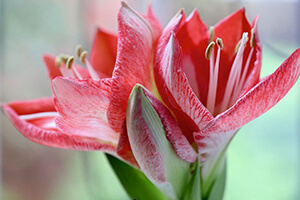
Amaryllis: the holiday bulb that keeps on giving
When it’s gloomy and gray outdoors, bring some fragrance and colorful blossoms into your home by growing amaryllis and paperwhite narcissus. Both are grown from bulbs and the blossoms can last anywhere from a couple of weeks to a month or more. Forcing them into bloom indoors during the winter is really quite natural for these tropical bulbs.
The key is to purchase firm bulbs as large as you can get them. I always order both from Longfield Gardens, an internet company that offers bulbs for all seasons. Paperwhite bulbs, should be at least the size of a baseball or tennis ball. Amaryllis are measured in centimeters and the best – from Longfield, of course – usually range from 32 to 36 centimeters, which translates to the size of a softball.
Both types of bulbs can be planted in potting soil or placed in containers atop 2 to 3 inches of washed pebbles or river rock. Flea markets, garage sales and charity stores offer affordable resources for containers that can range from wide 3- or 4-inch deep open bowls to tall cylindrical glass flower vases.
Fill the container with 2 to 3 inches of potting soil or pebbles. Place the bulbs flat side down on the soil or pebbles, then carefully add a bit more planting medium to keep the bulb stable. Fill to cover only the bottom third top half of the bulb. Moisten the soil or add water to the pebbles just to reach the roots.
Add a bit of aquarium charcoal when planting in water with river pebbles. This will help deter rotting and keep the growing medium fresh smelling.
Place the pots away from drafts but near a sunny window. Within a couple of days, green shoots will start to peek out from the bulbs and the white roots will begin to fill the container between the pebbles. Keep the soil-planted ones evenly moist. Make sure the water level stays right at the root-base of the ones in pebbles. From time to time, turn the containers to prevent the foliage or bloom stalks from growing toward the light.
If you’ve chosen good quality paperwhites, every bulb may produce three to four separate bunches of leaves with multiple bloom stalks each, which will appear after three to four weeks. If the plants become top-heavy, add a decorative element, such as some twiggy branches or even a tall plastic candy cane, tie a ribbon around the leaves and secure with a pretty bow. If you’ve used a cylindrical vase, the problem of floppy leaves is solved.
For amaryllis, the bloom stalks will appear first, edging their way out of the massive bulbs as flower buds with multiple blossoms on each thick stem.
Your paperwhites may bloom for several weeks, carrying your winter cheer from Christmas into January. Cut early blossoms for bud vases or bouquets; as flowers fade remove the entire stalk from the plant. Let the bulbs complete their bloom cycle. Sometimes you’ll be surprised by a late growing flower stalk, so don’t give up too early.
After all the paperwhite bulbs have blossomed and the foliage begins to fade, discard them. There’s no reason to save them for next year; the stress of forcing them wears them out and they can’t be regrown. Keep the container and the pebbles to use next year.
Amaryllis, on the other hand, are the holiday bulb that keeps on giving. Each year, I allow the foliage to grow until it begins to turn brown. Then I take them from their pots, allow them to dry out a bit and – when it’s past all chance of frost – plant them outdoors.
They make a really showy flower bed and after a season or two will revert to putting out blooms in the late spring and early summer. They make great flowers to cut and bring indoors; they have a long vase life.
Photo: Pixabay







